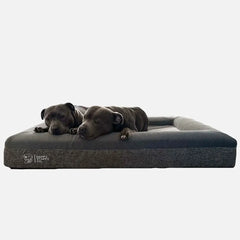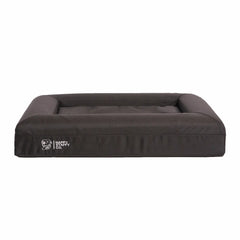From small pups that sprawl out like starfish to large breeds that curl into tight circles, every dog has unique resting habits that influence what size orthopedic bed will offer the best support. Choosing a bed that’s too small may cause discomfort and force your pet into unnatural sleeping positions, while an overly large one might lack the support structure needed to cradle joints properly. To choose the right size orthopedic bed, you need to measure your dog from nose to tail while they’re lying down and add a few extra inches for full-body support.
At Happy Staffy Co., we understand how important this decision is and offer a full collection of dog beds, orthopedic dog beds, and bed covers designed to meet the needs of dogs across sizes and breeds. From small pups that sprawl out to large breeds that curl into tight circles, every dog has unique resting habits that influence what size orthopedic bed will offer the best support. Choosing a durable bed that’s too small may cause discomfort and force your pet into unnatural sleeping positions, while an overly large one might lack the support structure needed to cradle joints properly. By assessing your dog’s behavior and dimensions alongside essential product specs, you can confidently invest in a bed that delivers lasting relief and restorative sleep.
Key Takeaways
-
Orthopedic bed size must match your dog’s sleeping style to ensure proper joint support and restful sleep.
-
Accurate body measurements help determine the right bed dimensions—add extra centimetres for movement and comfort.
-
Different breeds require different shapes and thicknesses based on weight, build, and health conditions like arthritis.
-
Room placement and lifestyle habits affect ideal bed size, especially for travel, crates, or multi-dog households.
-
Foam thickness is just as important as size, especially for large or senior dogs who need firmer, more durable support.
Understanding Why Size Matters for Orthopedic Beds
Orthopedic dog beds are designed to distribute weight evenly and reduce pressure on joints, which is crucial for dogs with arthritis, hip dysplasia, or recovering from surgery. But these benefits are only maximized when the bed matches your dog’s size and build. A bed that’s too small doesn’t offer full-body support, while a bed that’s too large can create sinking zones, diminishing its orthopedic value. The right fit ensures that the memory foam or pressure-relieving material contours properly to your dog’s body, especially the spine, hips, and elbows.
Many dog owners assume that weight alone determines bed size, but length and height matter just as much. A tall, lean Greyhound and a stocky English Bulldog may weigh the same but have vastly different space needs. To avoid misjudging, take accurate measurements while your dog is lying in their most common sleeping position—whether stretched out or curled up. Add a few inches of buffer space to accommodate movement without compromising support.
How to Measure Your Dog for the Right Fit
To ensure the orthopedic bed supports your dog’s full frame, start by measuring from the tip of the nose to the base of the tail while your dog is lying down. Next, measure shoulder width and paw extension to account for stretch. Add 6 to 12 inches to these measurements to determine the optimal bed dimensions.
Here are key steps:
-
Length: Nose to tail base
-
Width: Shoulder to shoulder or full leg extension
-
Height (optional): For raised orthopedic beds
Use these figures to compare against bed size charts provided by reputable manufacturers. If your dog is still growing or you’re in between sizes, choose the larger option for better longevity.
Visual Size Guide Example
To further assist in choosing the right size, here’s an example size guide that compares Medium and Large orthopedic beds specifically designed for Staffies:
-
Medium Bed
-
Internal Dimensions: 62cm x 42cm
-
External Dimensions: 94cm x 74cm
-
Recommended for Staffies under 25kg, approximately under 65cm in length
-
Large Bed
-
Internal Dimensions: 83cm x 58cm
-
External Dimensions: 115cm x 90cm
-
Ideal for American Staffies over 25kg and up to 40kg, approximately 65cm to 96cm in length
For dogs over 25kg, it’s recommended to opt for the large size to ensure proper support and comfort.
Matching Sleep Styles to Bed Size and Shape
Dogs have distinct sleep styles: some sprawl, others curl, and some switch positions frequently. An orthopedic bed should accommodate these tendencies to ensure restful, pain-free sleep. Dogs that sprawl need rectangular beds with extra room on all sides. Those who curl up may feel more secure on oval or bolster beds that hug their shape and provide head and neck support.
Observing your dog for a few nights can reveal patterns that inform your choice. Sprawlers need more length and width, while cuddlers benefit from slightly smaller, cozier beds that maintain warmth. For multi-position sleepers, choose a generously sized rectangular orthopedic bed with memory foam that evenly supports varying pressure points.
Considering Breed-Specific Needs and Preferences
Large breeds like German Shepherds, Labradors, and Great Danes often require XL or XXL orthopedic beds that maintain structural integrity under significant weight. These dogs are also more prone to joint issues, making a high-density memory foam core essential.
Small breeds, such as Dachshunds or Chihuahuas, may prefer beds with raised edges for burrowing or security. Even if they don’t need as much surface area, their beds should still provide firm, pressure-relieving support to prevent spinal strain. Medium breeds often fall into a gray area where flexibility in dimensions and design is most important.
Don’t forget about mixed-breed dogs, whose size and sleep preferences may not align with standard sizing charts. In these cases, a hybrid approach—taking measurements, observing behavior, and considering breed characteristics—offers the best guidance.
Room Placement and Lifestyle Considerations
Where you place the orthopedic bed can also affect the size you choose. Beds in crates or corners may need to fit within limited dimensions, while those placed in open areas can be more expansive. If your dog sleeps in a high-traffic room, opt for a bed with low sides to avoid tripping hazards.
Additionally, consider your lifestyle. If you travel often with your pet, you might need a portable orthopedic bed that balances size with ease of transport. For homes with multiple dogs, individual beds sized to each dog are ideal, though some companions enjoy sharing a larger one—just ensure it still offers enough structured support for each animal.
Materials and Thickness Matter, Too
Size isn’t just about dimensions. The thickness and material quality of the orthopedic foam determine how well it supports your dog’s body. For heavier dogs, thicker and denser foam is necessary to prevent bottoming out. A 4- to 6-inch medical-grade memory foam core is generally recommended for large breeds, while smaller dogs may be comfortable on 2- to 3-inch options.
Look for orthopedic beds with certifications for non-toxic materials and those that retain shape over time. A removable, washable cover also extends the bed’s lifespan and maintains hygiene, especially important for senior dogs or those with incontinence.
When to Upgrade or Replace Your Dog's Bed
Even the best orthopedic dog beds wear out. Signs it’s time to replace include visible sagging, thinning foam, stains from frequent peeing, excessive scratching, or signs of chewing damage. Reduced interest from your pet in using the bed may also indicate discomfort. Monitor how your dog gets up—if they seem stiff or reluctant, the bed may no longer be providing enough relief.
Puppies or adolescent dogs may also outgrow their beds within months, requiring frequent reassessments. Dogs recovering from surgery or medical treatments may need a temporary switch to a more specialized or cleaner surface. For aging dogs with increasing mobility issues, periodic upgrades ensure they continue receiving the joint support needed for comfort and quality of life.
Choosing an orthopedic dog bed isn’t a one-size-fits-all decision. The right size ensures lasting comfort, proper alignment, and meaningful health benefits. Take the time to measure, observe, and consider your dog’s individual needs to make a decision that supports their daily well-being.



